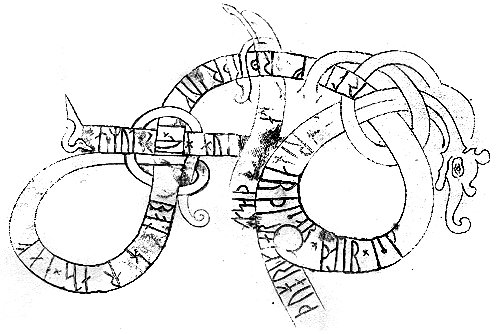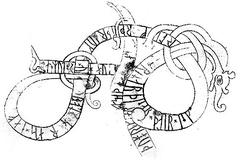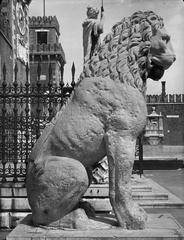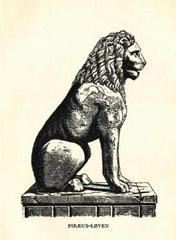
Piraeus Lion Venice: Visiting Hours, Tickets, and Complete Visitor Guide
Date: 15/06/2025
Introduction: The Piraeus Lion—A Mediterranean Marvel
Standing sentinel at the entrance to Venice’s historic Arsenale, the Piraeus Lion is a monumental marble sculpture whose journey and symbolism encapsulate over two millennia of Mediterranean history. Originally carved from pristine white marble around 360 BCE, this ancient lion once guarded the harbor of Piraeus, Athens’ principal port, symbolizing protection, strength, and the city’s maritime prowess. Its dramatic relocation to Venice in the late 17th century, following its seizure during the Great Turkish War, transformed the lion into a powerful emblem of Venetian naval dominance and cross-cultural exchange (Ancient Origins; VeniceWiki).
Today, the Piraeus Lion is renowned not only for its Greek artistic origins but also for its rare 11th-century Viking runic inscriptions. These enigmatic carvings, made by Varangian mercenaries in Byzantine service, make the lion one of the most intriguing Norse artifacts in the Mediterranean (Atlas Obscura; The Byzantine Legacy).
This guide explores the Piraeus Lion’s origins, symbolic significance, and practical visitor information—including hours, tickets, accessibility, and nearby attractions—helping you plan an enriching visit to this iconic Venetian landmark.
Table of Contents
- Introduction: Why Visit the Piraeus Lion?
- The Lion’s Historical Background
- Artistic and Archaeological Highlights
- Symbolism in Venetian Culture
- Visitor Information
- Conservation and Preservation
- Frequently Asked Questions (FAQ)
- Visual Resources and Media
- Conclusion: Experiencing the Piraeus Lion
- References
The Piraeus Lion: A Guardian of Ancient Athens
Sculpted in the 4th century BCE, the Piraeus Lion originally stood at the entrance to Piraeus harbor, serving as a guardian and symbol of Athens’ naval strength (Atlas Obscura). The lion’s commanding presence was so influential that the harbor itself was dubbed “Porto Leone” (Lion Port) by sailors and cartographers (Greek Reporter). Its function may have extended beyond symbolism: a hole in the mouth and a groove along the back suggest it was part of a fountain (History Walks Venice).
From Athens to Venice: War, Conquest, and Cultural Appropriation
By the 17th century, Athens was under Ottoman control. In 1687, during the Sixth Ottoman-Venetian War, Venetian commander Francesco Morosini captured the city. The lion was taken as war booty and transported to Venice, where it was installed at the Arsenale’s main entrance (Ancient Origins; ftrc.blog). This relocation was not only an act of triumph but also a symbolic gesture, aligning with Venice’s own lion iconography through its patron saint, St. Mark (Wikipedia).
Viking Runes: An Unexpected Norse Connection
One of the Piraeus Lion’s most distinctive features is the runic inscriptions carved into its shoulders and flanks. These inscriptions, made by Scandinavian (likely Varangian) mercenaries during the 11th century, are among the earliest Norse writings discovered in the Mediterranean (Ancient Origins; ftrc.blog). Identified as runes in the late 18th century, their partial legibility today is due to centuries of weathering. The runes are arranged in a ribbon-like band, possibly representing a lindworm—a mythical dragon of northern Europe (Ancient Origins).
Artistic and Archaeological Features
The Piraeus Lion stands about 3 meters tall and displays the stylized mane and muscular form characteristic of late Classical Greek sculpture. The statue’s imposing stance and lifelike details demonstrate the technical mastery of its creators. Traces of the original water conduit reinforce theories of its use as a fountain (History Walks Venice).
Symbolism of the Lion in Venetian Culture
The Lion as Emblem
Lions are omnipresent in Venetian iconography, symbolizing the city’s power and its patron, St. Mark the Evangelist. The winged lion, often shown with a book inscribed “Pax tibi Marce, evangelista meus,” reflects Venetian sovereignty and divine protection (Italy Notes; TripAnthropologist).
Unique Position of the Piraeus Lion
Unlike Venice’s iconic winged lions, the Piraeus Lion is a classical Greek sculpture. Its presence at the Arsenal underscores Venice’s ability to assimilate and repurpose symbols from other cultures. The Norse runes distinguish it further, marking the lion as a testament to the city’s cosmopolitan past (The Byzantine Legacy).
Visiting the Piraeus Lion: Practical Information
Current Location and Setting
- Address: Entrance to the Venetian Arsenal (Arsenale di Venezia), Campo de l’Arsenale, Castello, Venice.
- Surroundings: The lion stands outside the Arsenal’s main gate, alongside three other ancient lion statues (VeniceWiki; myadventurouswings.com).
Visiting Hours and Tickets
- Hours: The Piraeus Lion is outdoors and accessible at any time, though daylight hours (typically 9:00 AM to 6:00 PM) are best for viewing.
- Tickets: No ticket or entrance fee is required to view the lion. The Arsenal grounds are generally closed to the public except during special events (e.g., the Venice Biennale), which may require tickets (Trip.com).
How to Get There
- By Vaporetto: The nearest stops are “Arsenale” and “Celestia.” Both are a short walk to the Arsenal entrance.
- On Foot: From Piazza San Marco, walk east along the Riva degli Schiavoni for about 10–15 minutes.
Accessibility
- The area around the lion is on flat ground and is accessible to wheelchairs and strollers.
- Be aware that Venice’s cobblestone streets and bridges may present challenges elsewhere.
Nearby Attractions
- Museo Storico Navale: Venice’s Naval History Museum, just steps away, provides deeper insight into the city’s maritime legacy.
- Doge’s Palace and St. Mark’s Basilica: Major landmarks within walking distance.
- Riva degli Schiavoni: A scenic waterfront promenade ideal for picturesque walks and photography.
Guided Tours and Special Events
- While the Arsenal itself is generally restricted, special events (such as the Venice Biennale) may include limited guided tours. Check the Venice Biennale website or local listings for updates.
Conservation and Preservation
The Piraeus Lion’s marble has endured centuries of weathering. Conservation efforts focus on stabilizing the stone and safeguarding the runic inscriptions. Visitors are encouraged to admire but not touch or climb the statue to help preserve its condition (Atlas Obscura).
Frequently Asked Questions (FAQ)
Q: What are the Piraeus Lion’s visiting hours?
A: The statue is outdoors and visible 24/7; daylight hours are recommended for viewing.
Q: Is there an entrance fee or ticket required?
A: No, viewing the lion is free. Tickets are only needed for special events or nearby museums.
Q: Are guided tours available?
A: Historical tours of Venice often include the Arsenal area and the Piraeus Lion. Inside Arsenal access is limited except during special events.
Q: Is the site wheelchair accessible?
A: Yes, the area around the lion is accessible.
Q: Can I touch or climb the statue?
A: No. Please refrain from touching or climbing to help preserve the sculpture.
Visual Resources and Media Recommendations
- Photography Tips: Early morning and late afternoon light enhance the lion’s marble texture.
- Alt Tags Suggestion: Use tags such as “Piraeus Lion Venice marble statue with runic inscriptions” for accessibility.
- Interactive Map: Venice Arsenal on Google Maps
Replicas and the Lion’s Enduring Legacy
Replicas of the Piraeus Lion are displayed at the Piraeus Archaeological Museum in Greece and the Swedish History Museum in Stockholm (Wikipedia). These copies highlight the lion’s enduring significance across Europe.
Conclusion: Experiencing the Piraeus Lion
The Piraeus Lion is not merely a relic; it is a vibrant symbol of the Mediterranean’s layered history—blending Greek artistry, Norse adventurism, Byzantine legacy, and Venetian grandeur. Free to visit and easy to access, the lion is a must-see for anyone exploring Venice’s rich tapestry of art, history, and culture. Enhance your experience by combining your visit with nearby museums or guided tours, and plan for optimal lighting for memorable photographs.
For more travel tips, real-time updates, and curated guides, download the Audiala app, follow us on social media, and explore related articles on Venice’s historical treasures.
References
- Ancient Origins - The Piraeus Lion
- VeniceWiki - Leoni dell’Arsenale
- Atlas Obscura - Piraeus Lion
- The Byzantine Legacy - Piraeus Lion
- Italy Notes - The Piraeus Lion in Venice
- TripAnthropologist - The Lions of Venice
- myadventurouswings.com - Visiting the Piraeus Lion in Venice
- History Walks Venice - Runes in Venice
- Greek Reporter - Ancient Greek Lion of Piraeus
- ftrc.blog - Piraeus Lion
- Trip.com - Piraeus Lion















































































































